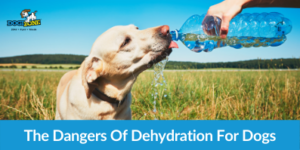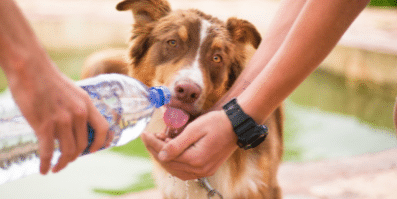The Dangers Of Dehydration For Dogs
The summer months are a great time to go hiking, play at the dog park, or simply go on long walks around the neighborhood or on a local trail. July has officially been designated as National Pet Hydration Awareness month to help pet owners understand the dangers of dehydration for dogs. 
Most people are very conscious of the amount of water they need to drink in a day. However, these same people often forget their dogs and cats need to also ramp up their water intake when temperatures soar into the high double digits and above.
It may be surprising to note that dogs and cats have more water in their systems than humans. The human body is made up of about 60% water, while the bodies of dogs and cats are 80% water. This means that pets need to replenish water lost through panting and sweating more frequently to maintain their metabolic balance.
Early Signs of Dangers of Dehydration for Dogs
Pets can become dehydrated with activity, but they can also become dehydrated in high-temperature environments even if they are relatively inactive. The first signs of dehydration include excessive panting combined with a dry mouth.

A quick way to test for dehydration is to pinch the skin on the back of the neck or between the dog’s shoulder blades. You may need to part the hair to see the skin on dogs with long hair or double coats. The skin should immediately fall or snap back into place if the dog is hydrated. If the skin remains in the pinched position or is very slow to return to the normal flat position, your dog could be dehydrated. Call a vet, provide your pet with water, and get the animal out of the sun into a cool place.
More Advanced Signs of Dehydration
Dehydration can progressively become worse, potentially posing a life-threatening condition in a short period of time. More advanced signs of dehydration include loss of appetite, vomiting, diarrhea, sunken eyes, and lethargy. Dogs may collapse or have seizures if the dehydration is combined with heatstroke. There may be other underlying health conditions that are contributing to dehydration.
Any of these signs means an immediate emergency trip to the vet. At this point, simply providing water will not rehydrate the dog significantly. An IV is typically used to hydrate the dog and provide the necessary fluids for the body to continue to function.
Keeping Pets Hydrated
To help keep your dog hydrated, place water in easy-to-access places. Keep water bowls clean and full of fresh cool water on a daily basis. For dogs that do not naturally drink water, consider adding a small amount of sodium-free chicken or beef stock for added flavor.
Adding water to food can also help to increase water consumption on hot days, but remember to remove any leftover food after meals to avoid insects and flies in the area and around your dog’s food.

